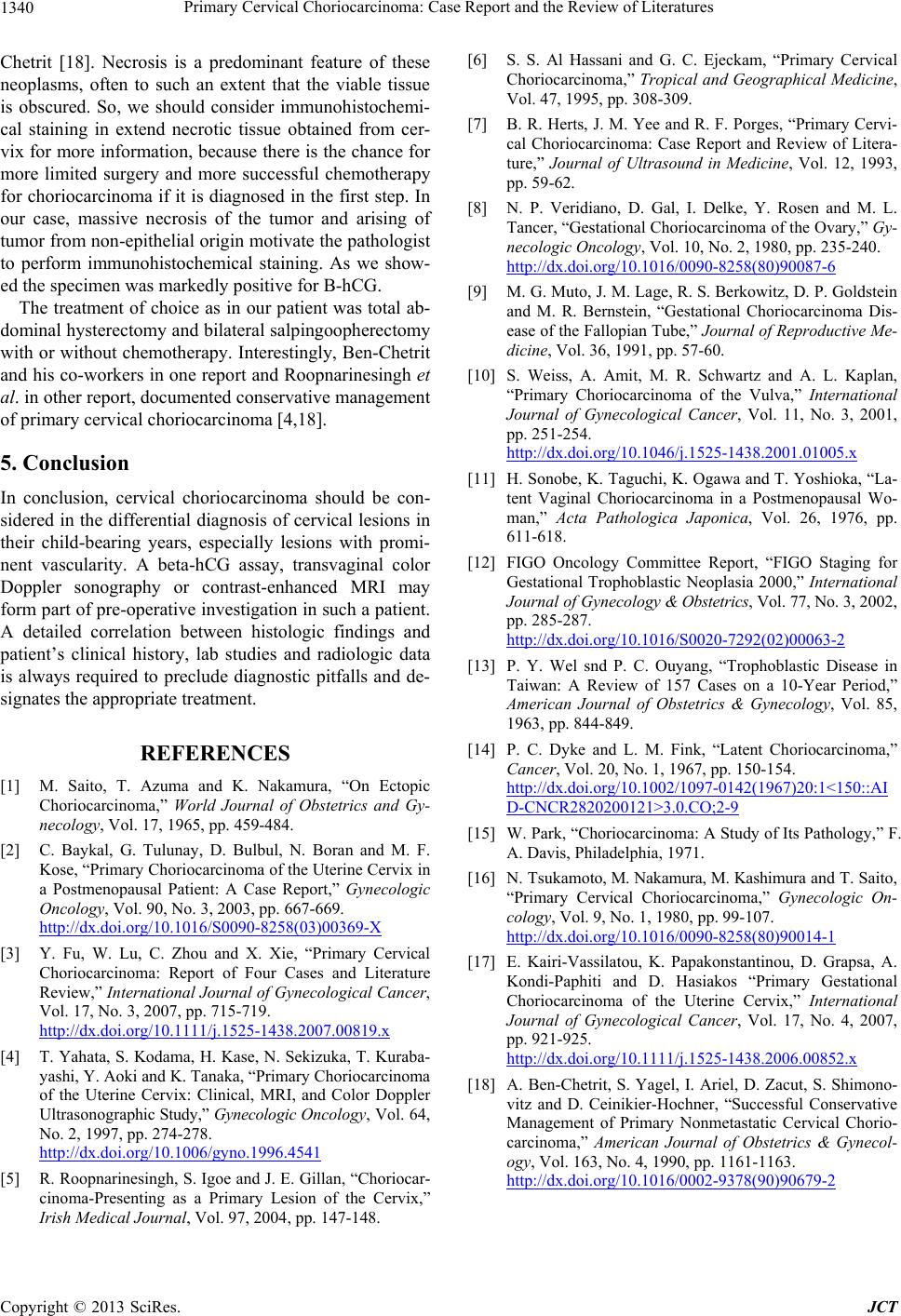
Primary Cervical Choriocarcinoma: Case Report and the Review of Literatures
Copyright © 2013 SciRes. JCT
1340
Chetrit [18]. Necrosis is a predominant feature of these
neoplasms, often to such an extent that the viable tissue
is obscured. So, we should consider immunohistochemi-
cal staining in extend necrotic tissue obtained from cer-
vix for more information, because there is the chance for
more limited surgery and more successful chemotherapy
for choriocarcinoma if it is diagnosed in the first step. In
our case, massive necrosis of the tumor and arising of
tumor from non-epithelial origin motivate the pathologist
to perform immunohistochemical staining. As we show-
ed the specimen was markedly positive fo r B-hCG.
The treatment of choice as in our patient was total ab-
dominal hysterectomy and bilateral salpingoopherectomy
with or without chemotherapy. In terestingly, Ben-Chetrit
and his co-worke rs in one report and Roopnarinesingh et
al. in other report, documented conservative management
of primary cervical choriocarcinoma [4,18].
5. Conclusion
In conclusion, cervical choriocarcinoma should be con-
sidered in the differential diagnosis of cervical lesions in
their child-bearing years, especially lesions with promi-
nent vascularity. A beta-hCG assay, transvaginal color
Doppler sonography or contrast-enhanced MRI may
form part of pre-operative investigation in such a patient.
A detailed correlation between histologic findings and
patient’s clinical history, lab studies and radiologic data
is always required to preclude diagnostic pitfalls and de-
signates the appropriate treatment.
REFERENCES
[1] M. Saito, T. Azuma and K. Nakamura, “On Ectopic
Choriocarcinoma,” World Journal of Obstetrics and Gy-
necology, Vol. 17, 1965, pp. 459-484.
[2] C. Baykal, G. Tulunay, D. Bulbul, N. Boran and M. F.
Kose, “Primary Choriocarcinoma of the Uterine Cervix in
a Postmenopausal Patient: A Case Report,” Gynecologic
Oncology, Vol. 90, No. 3, 2003, pp. 667-669.
http://dx.doi.org/10.1016/S0090-8258(03)00369-X
[3] Y. Fu, W. Lu, C. Zhou and X. Xie, “Primary Cervical
Choriocarcinoma: Report of Four Cases and Literature
Review,” International Journal of Gynecological Cancer,
Vol. 17, No. 3, 2007, pp. 715-719.
http://dx.doi.org/10.1111/j.1525-1438.2007.00819.x
[4] T. Yahata, S. Kodama, H. Kase, N. Sekizuka, T. Kuraba-
yashi, Y. Aoki and K. Tanaka, “Primary Choriocarcinoma
of the Uterine Cervix: Clinical, MRI, and Color Doppler
Ultrasonographic Study,” Gynecologic Oncol ogy , Vol. 64,
No. 2, 1997, pp. 274-278.
http://dx.doi.org/10.1006/gyno.1996.4541
[5] R. Roopnarinesingh, S. Igoe and J. E. Gillan, “Choriocar-
cinoma-Presenting as a Primary Lesion of the Cervix,”
Irish Medical Journal, Vol. 97, 2004, pp. 147-148.
[6] S. S. Al Hassani and G. C. Ejeckam, “Primary Cervical
Choriocarcinoma,” Tropical and Geographical Medicine,
Vol. 47, 1995, pp. 308-309.
[7] B. R. Herts, J. M. Yee a nd R. F. Porges, “Primary Cervi-
cal Choriocarcinoma: Case Report and Review of Litera-
ture,” Journal of Ultrasound in Medicine, Vol. 12, 1993,
pp. 59-62.
[8] N. P. Veridiano, D. Gal, I. Delke, Y. Rosen and M. L.
Tancer, “Gestational Choriocarcinoma of the Ovary,” Gy-
necologic Oncology, Vol. 10, No. 2, 1980, pp. 235-240.
http://dx.doi.org/10.1016/0090-8258(80)90087-6
[9] M. G. Muto, J. M. Lage, R. S. Berkowitz, D. P. Goldste in
and M. R. Bernstein, “Gestational Choriocarcinoma Dis-
ease of the Fallopian Tube,” Journal of Reproductive Me-
dicine, Vol. 36, 1991, pp. 57-60.
[10] S. Weiss, A. Amit, M. R. Schwartz and A. L. Kaplan,
“Primary Choriocarcinoma of the Vulva,” International
Journal of Gynecological Cancer, Vol. 11, No. 3, 2001,
pp. 251-254.
http://dx.doi.org/10.1046/j.1525-1438.2001.01005.x
[11] H. Sonobe, K. Taguchi, K. Ogawa and T. Yoshioka, “La-
tent Vaginal Choriocarcinoma in a Postmenopausal Wo-
man,” Acta Pathologica Japonica, Vol. 26, 1976, pp.
611-618.
[12] FIGO Oncology Committee Report, “FIGO Staging for
Gestational Trophoblastic Neoplasia 2000,” International
Journal of Gynecology & Obstetrics, Vol. 77, No. 3, 2002,
pp. 285-287.
http://dx.doi.org/10.1016/S0020-7292(02)00063-2
[13] P. Y. Wel snd P. C. Ouyang, “Trophoblastic Disease in
Taiwan: A Review of 157 Cases on a 10-Year Period,”
American Journal of Obstetrics & Gynecology, Vol. 85,
1963, pp. 844-849.
[14] P. C. Dyke and L. M. Fink, “Latent Choriocarcinoma,”
Cancer, Vol. 20, No. 1, 1967, pp. 150-154.
http://dx.doi.org/10.1002/1097-0142(1967)20:1<150::AI
D-CNCR2820200121>3.0.CO;2-9
[15] W. Park, “Choriocarcinoma : A Study of Its Pathology,” F.
A. Davis, Philadelphia, 1971.
[16] N. T su k a mo to, M. Nakamura, M. Kashimura and T. Saito,
“Primary Cervical Choriocarcinoma,” Gynecologic On-
cology, Vol. 9, No. 1, 1980, pp. 99-107.
http://dx.doi.org/10.1016/0090-8258(80)90014-1
[17] E. Kairi-Vassilatou, K. Papakonstantinou, D. Grapsa, A.
Kondi-Paphiti and D. Hasiakos “Primary Gestational
Choriocarcinoma of the Uterine Cervix,” International
Journal of Gynecological Cancer, Vol. 17, No. 4, 2007,
pp. 921-925.
http://dx.doi.org/10.1111/j.1525-1438.2006.00852.x
[18] A. Ben-Chetrit, S. Yagel, I. Ariel, D. Zacut, S. Shimono-
vitz and D. Ceinikier-Hochner, “Successful Conservative
Management of Primary Nonmetastatic Cervical Chorio-
carcinoma,” American Journal of Obstetrics & Gynecol-
ogy, Vol. 163, No. 4, 1990, pp. 1161-1163.
http://dx.doi.org/10.1016/0002-9378(90)90679-2